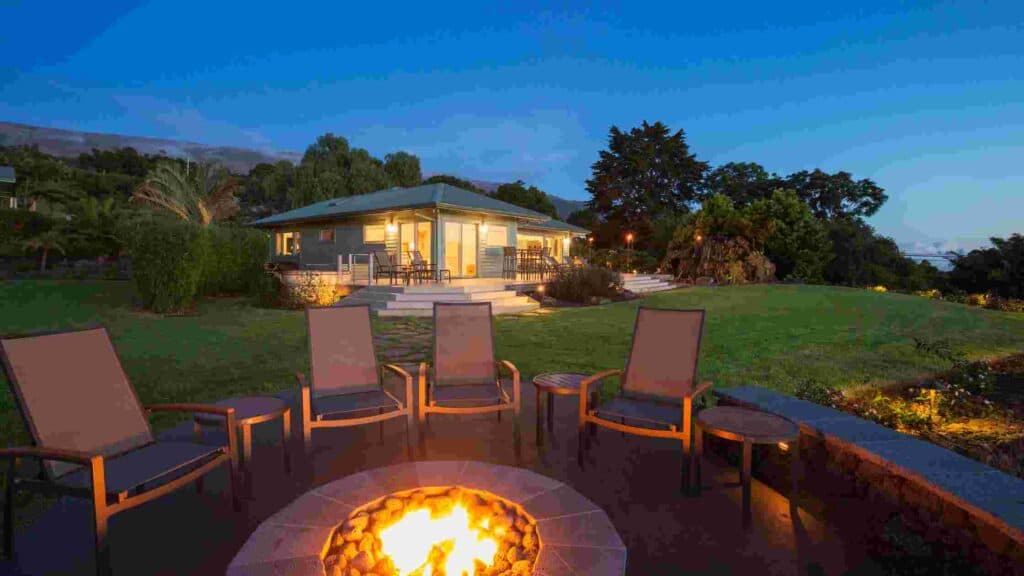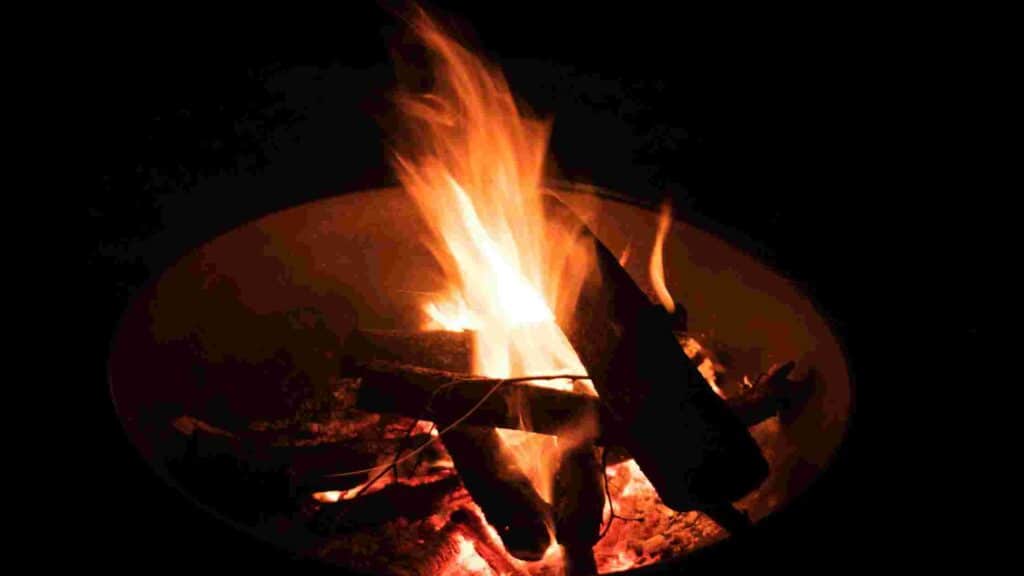If you are captivated by the mesmerizing allure of a crackling fire, you might be wondering – can I have a fire pit in my backyard?
There’s something undeniably magical about the dancing flames that draws us in. While fire is no longer essential for survival, it continues to hold a special place in our collective DNA. But before you add a fire pit to your backyard, you need to think about its legality.
If having a fire pit is on your honey-do list, you’re certainly not alone. According to the American Society of Landscape Architects, it ranks as the fourth most requested landscaping element. And it makes perfect sense, considering our passion for grilling.
Americans love firing up the barbecue, even during colder times of the year. After all, who wouldn’t want to stay warm while flipping burgers and sizzling brats?
Now, grills are generally unproblematic in terms of legality. But when it comes to an open fire, that’s a different story altogether. Valid concerns arise due to the potential risks involved.
Open fires are responsible for over 10,000 fires and approximately 19,000 emergency room visits each year. So, the burning question remains: Can you have a fire pit in your backyard?
Residential Fire Pit Regulations – Can I Have A Fire Pit In My Backyard?
The legality of having a fire pit largely depends on local regulations.
The US Environmental Protection Agency (EPA) recognizes the popularity of recreational fires among Americans, whether it involves a charcoal grill or a fire pit. However, the agency’s involvement is primarily focused on what you burn inside your home and the appliances you use.
But things change when we step outside…
Safety becomes a significant concern, particularly with regard to fire risks. If there’s sufficient dry foliage surrounding the fire pit, a fire can spread rapidly.
Let’s face it, not everyone has a shovel and garden hose readily available in case of an emergency. Consequently, the local government often plays a vital role in determining whether you can have a fire pit in your backyard. Therefore, we strongly advise checking with your city authorities before striking that first match.
Some areas outright prohibit fires of any kind, while others may require permits and associated fees. Additionally, there might be specific distance requirements from your home.
Fire Pit Code Distance From House – Fire Pit Code Requirements

Assuming you’ve done your due diligence and received the necessary permissions and approvals, let’s discuss how to make the most of your fire pit while prioritizing safety.
Choosing a fire pit with durability as the primary feature is crucial. It should be able to withstand the weight of the wood and the stress of temperature changes, making cast iron an excellent option.
The location of your fire pit is also essential. We recommend placing it at least 10 feet away from your house and any areas where you store extra wood. Stray sparks finding their way to these places could spell trouble.
Additionally, it’s wise to clear the surrounding area of brush or flammable materials that could easily catch fire. Prepare everything you need to start the fire while it’s still light outside to avoid fumbling around in the dark for additional logs
Seek Permission, Not Forgiveness
Rather than seeking forgiveness afterward, it’s wiser to obtain permission in advance. Your local government’s regulations and fire safety measures are crucial factors to consider.
Certain towns might specify the types of fires allowed and the fuels you can use. They often differentiate between recreational fires and burning yard waste.
Although we adore the scent of burning leaves, some municipalities might prohibit it. To stay on the right side of the law, it’s essential to carefully review the fine print.
Generally, these regulations depend on the population density of the area. In rural regions, you’re more likely to be permitted to have a fire pit. However, if you reside in a suburb or urban area, you may encounter more obstacles. The heat island effect contributes to these restrictions.
Cities tend to have higher ambient temperatures compared to rural areas. With numerous buildings and impervious surfaces like roads and parking lots absorbing and retaining heat, the urban environment interferes with smoke dispersion, posing potential health concerns.
Starting a fire in an urban setting carries higher stakes compared to a rural environment. This is why you’ll often find that fires of any kind are not allowed in city limits.
How Do You Make A Fire Pit Safe?
When it comes to having a fire pit in your backyard, there are a few additional factors you should consider to ensure a safe and enjoyable experience. Let’s dive into these important considerations.
1. House Rules And Safety
When it comes to having fires, especially if you have small children, it’s important to establish and enforce clear house rules. Only adults should tend to the fire and add wood—no exceptions. Use this opportunity as a teaching moment to help children understand and respect the power of fire.
2. Apartment Living And HOA Fire Pit Rules
If you reside in an apartment, it’s essential to consult with your landlord or property manager regarding the use of fire pits or on-site burning.
Lease agreements often specify whether these activities are permitted. The same precaution applies to homeowners’ associations (HOAs).
If you’ve signed a contract, it is your legal obligation to adhere to all rules, including those related to fire pits and other landscaping elements.
3. Insurance Coverage
Another crucial point to keep in mind is your renter’s or homeowner’s insurance policy. It’s worth checking the terms and conditions to see if any mishaps related to fire pits are covered. You don’t want to find yourself in a situation where you’re not protected if something goes wrong.
4. Considering Your Health And Wood Smoke
Now, let’s address the elephant in the room—smoke. Even when burning dry, seasoned wood, harmful chemicals like formaldehyde, a known carcinogen, are released. Not to mention the particulate matter that can be inhaled.
Regular exposure to wood smoke through frequent fires can increase the risk of developing chronic obstructive lung disease (COPD). Vulnerable individuals such as children, the elderly, and those with compromised immune systems are particularly at risk.
While this is not a legal matter, it’s a matter of common sense. If someone in your household has a respiratory condition or asthma, it might not be wise to invest in a fire pit. In any case, ensure there is ample air circulation around your fire pit to minimize health risks.
5. Environmental Impact And Wood Smoke
The potential harm caused by fires extends beyond human health—it also affects the wildlife and environment. Visibility can be a concern as well.
A large blaze in your fire pit, especially when using wet or green wood, can impact air quality and create haze. This can have implications for traffic and, under certain conditions, lead to undesirable consequences.
It’s important to be mindful of the potential environmental impact when enjoying your fire pit.
6. Taking Additional Precautions
Before starting any fire, whether in a fire pit or a campfire ring, it’s essential to check the weather conditions. As a general rule, it’s best to avoid lighting a fire if the wind speed exceeds 10 mph.
If you don’t have access to a smartphone or weather app, you can observe the movement of leaves in the trees or check for white caps on nearby bodies of water.
If you notice significant movement or choppiness, it’s a sign that the wind speed is likely too high, making it unsafe to have a fire.
Also, consider the direction of the wind. It’s important to be mindful of your neighbors and ensure that the smoke doesn’t blow into their homes. Additionally, if precipitation is on the way, the smoke may stay closer to the ground, intensifying its effect. So, it’s wise to take these factors into account for a considerate and enjoyable fire experience.
As mentioned earlier, always keep a shovel and a garden hose nearby when using your fire pit. Stray sparks can pose a significant risk and potentially cause havoc during your otherwise relaxing evening.
Moreover, never leave a fire smoldering. Make sure it is completely extinguished before you retreat indoors. A sudden gust of wind can easily stir up the embers and reignite the fire, leading to unexpected and unwanted consequences.
Choosing The Right Fuel And Taking Precautions For Your Fire Pit

When it comes to fuel options for your fire pit, there are various choices available. While some people opt for LP (liquefied petroleum) fuel, a majority of fire pit enthusiasts prefer the classic charm of wood.
Wood is not only cost-effective and easily accessible but also offers a pleasant aroma. If you decide to go the wood-burning route, ensure that you use store-bought or natural wood. This guarantees that you’re burning clean and safe fuel without any unpleasant surprises or foul odors.
However, it’s important to avoid certain materials that can jeopardize the safety of your fire pit. Say no to treated lumber or other manufactured products, as they may contain harmful chemicals from paints or other substances. The list of prohibited items doesn’t end there.
Here are some other no-nos to keep in mind:
- Particleboard
- Styrofoam
- Poison ivy
- Plastic
- Pallets
Remember, these materials can compromise the safety and enjoyment of your fire pit, so it’s best to steer clear of them.
And one last note: leave the can of lighter fluid on the shelf (be sure to check out the best outdoor shelving options). Trust us, you don’t want to be that person.
FAQs – Can You Have A Fire Pit In Your Backyard?
1. Can I have a fire in my fire pit today?
Whether you can have a fire in your fire pit today depends on local regulations and any current restrictions or burn bans in place. Check with your local authorities or fire department for the latest information.
2. Can I burn leaves in my backyard?
Some areas allow it, while others may have restrictions or provide alternative methods for leaf disposal. Check with your local authorities for guidelines on leaf burning.
3. Can you have a small fire pit in your backyard?
Having a small fire pit in your backyard is generally allowed, but it’s important to comply with local regulations and obtain any necessary permits. Check with your local authorities for specific guidelines on fire pit size and safety. Also, find out more in the article: Can you have a fire in your backyard?
4. Do I have to put out the fire from fire pit?
It is important to properly extinguish the fire from your fire pit before leaving it unattended or going to bed. Use water or sand to completely put out the flames and ensure there are no remaining embers or hot coals.
5. Can you have a fire pit under a covered area?
Having a fire pit under a covered area is dangerous due to the increased risk of fire spreading and the potential for smoke accumulation. It is not recommended to have a fire pit directly under a covered area. Follow manufacturer guidelines and local regulations for the safe placement and use of fire pits.
You might also be interested in: Can you have a fire pit on a deck?
Conclusion – Can I Have A Fire Pit In My Backyard?
Few things are as captivating and calming as the flickering flames of a fire. We fully understand its allure. The mesmerizing dance of the flames and the comforting warmth it provides create a unique ambiance. However, it’s crucial to prioritize both legality and safety.
Before lighting up your fire pit, ensure you are well informed about the regulations and guidelines governing fire pit usage in your backyard. This responsible approach will help you avoid any unintended fires and ensure a pleasant experience for everyone involved.
Remember, a little preparation and adherence to safety measures go a long way in enjoying your fire pit to the fullest. So, gather your loved ones, relish the enchantment of the flames, and create lasting memories while keeping safety as the centerpiece of your fire pit adventures.
